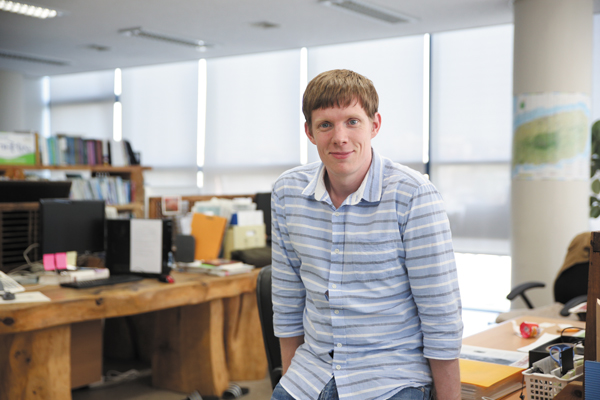| |
 |
|
| ▲ Darren Southcott led The Jeju Weekly as editor-in-chief for three years. |
Darren Southcott worked as editor-in-chief for The Jeju Weekly from March 2013 to March 2016. This is his farewell message to readers of the paper.
As I leave my position as editor, it is natural that my mind turns to change, reflection, and the unknown journey ahead for myself and the island.
In this act, despite the many memories I accrued over three-and-a-bit years as editor, there is one character that looms larger than all else: The island itself.
No matter who I met, or what I was writing about, this volcanic island was the personality that drew everything together.
Looming in the middle of the island, I have even become convinced that Mt. Hallasan is the center of the Universe.
It is not only that some of the most crucial issues facing the world converge around the dormant volcano, but that the island is a microcosm of our past, present and future.
In an age of growing international conflict and risk, Jeju is on the militaristic radar with its shiny new naval base at Gangjeong.
In the face of climate change post-COP21, Jeju is at the vanguard again with its carbon-free 2030 new and renewable energy plans.
| |
 |
|
| ▲ Darren Southcott led The Jeju Weekly as editor-in-chief for three years. |
It remains to be seen, however, whether this will actually decrease emissions as Jeju seeks to double its population and tourist numbers, and build a second airport in time for the age of the aerocity.
Having missed out on much of the rapid development that transformed mainland Korea in the 70s and 80s, Jeju is not only a bonanza for construction companies, but also a window onto Korea’s past.
Yet Jeju’s rich traditions and customs could go the same way as so many on the mainland, as markets and commodity fetishism become the arbiters of worth.
While I welcome the exciting growth of the ICT sector on Jeju, a future growth engine for sure, I wonder if a smartphone app will be the final resting place for the island’s mythology.
Even in this area, though, Jeju is trying to make itself the center: soon its international cultural heritage designations might match its much-trumpeted UNESCO triple crown in the natural sciences.
It is truly fascinating to see so many strands of global change happening on this East Asian emerald isle, even though the island is being pulled in both converging and diverging directions by policymakers.
Coming from England, where change is slower, and landscapes more permanent, the speed of change provokes uneasiness.
One thing more resistant to change, if not changeless, is that guardian looming large beyond the Venture Maru office windows: Mt. Hallasan.
Locals say the mountain is not only deep within islanders’ psyches, but is the first thing to greet them in the morning.
While the spiritual hold of the mountain is still strong, change is apparent; yellow dust, fine dust, and our island’s own pollution mean that Hallasan’s divine crown is often veiled in a hazy chokehold.
I often wonder if this mirrors modern society’s distance from the mountain’s spiritual essence, as apartments creep up the slopes of Aradong.
Perhaps Halla’s mountain spirit is cloaking itself away, trying to make sense of the changes that encroach on its woodlands.
| |
 |
|
| ▲ Darren Southcott led The Jeju Weekly as editor-in-chief for three years. |
Baek Uncheol of Jeju Stone Park believes that the “essence of the Jeju spirit and people” is within the living stones on its slopes.
A UNESCO official once told me, “It is very important to maintain the spiritual connection between Mt. Hallasan and the Jeju people.”
He was lamenting — in 2010 — the stress the mountain was under from a few thousand Chinese and 9 million domestic tourists.
I wonder what he thinks of Hallasan’s prospects now as the province feverishly courts 20 million tourists, a new airport and a 1 million-plus population.
But cultures everywhere change, some through sharp shocks and others through slow evolution.
On Jeju, we are currently seeing explosive artistic emergence rarely seen elsewhere, directly correlated to the pace of development, and Jeju’s engagement with its painful past and optimistic future.
As I seek deeper meaning in my years as editor for The Jeju Weekly, I return to this changing and changeless mountain, and everything it has witnessed.
I was extremely privileged to see that mountain every day, and learn some of the stories that are hidden in its valleys.
From within those deep clefts, the island’s future will soon reveal itself.
Thanks to everyone who supported me in my time with The Jeju Weekly. |






















